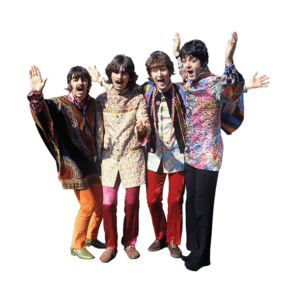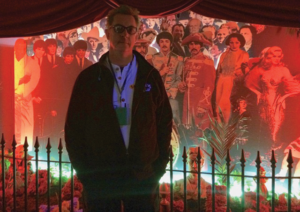It Was Fifty Years Ago Today …

Today (June 1) marks the fiftieth anniversary of The Beatles’ Sgt. Pepper’s Lonely Hearts Club Band, widely regarded as one of the greatest albums of all time. AHA Arts Editor Daniel Thomas Moran takes an in-depth look at the making of the classic record. This article was originally published in the May/June 2017 Humanist Magazine.
THE BEATLES may not have been the first to do many of the things that made them successful. George Harrison clipped guitar licks from Chuck Berry and Carl Perkins. Paul McCartney got his wail from Little Richard. Their warm and wonderful harmonies were inspired by the likes of the Everly Brothers. They also found themselves in an important cross-Atlantic competition with their American counterparts, the Beach Boys.
Starting with “I Want to Hold Your Hand” in January of 1964, right through to “Penny Lane” in February of 1967, they had thirteen number-one singles, and each of their first seven albums reached the top spot on the US Billboard charts, accomplishments that will likely never be equaled.
The world simply couldn’t get enough of the Beatles in the early-mid sixties, but by August 29, 1966, the Beatles—John Lennon, Paul McCartney, George Harrison, and Ringo Starr—had had enough of the Beatles. Fully drained and disillusioned by the demands of unimaginable fame, they played their last concert at San Francisco’s Candlestick Park. Exiting the field in an armored car, they looked at one another and agreed that they were done—not as a band but as a touring band.
A year earlier the Beatles had experienced their first LSD trips, the profound effects of which were first heard on the album Revolver. The transformation was somewhat startling, but they had begun to see themselves not as pop stars, but as creative artists. The end of their hellish, frenetic road tours had finally given John, Paul, George, and Ringo the one thing they had lacked for so long: time. The Beatles went into the recording studio along with their trusted producer George Martin, who was able to make profound recordings of all the ideas that sprang from them. Referred to as the “Fifth Beatle,” Martin was, in so many ways, the technical translator of their genius.
Alone with each other, and with their own thoughts, Martin and the band began to work on an idea that originated with McCartney. He wondered out loud just what it would be like if they stopped being the Beatles and allowed themselves to start fresh, feeling that it would open them to boundless possibilities. He tossed out a new name that was, at once, whimsical and provocative: Sgt. Pepper’s Lonely Hearts Club Band.
Alongside their drug experiences, the Beatles were influenced by the psychedelic counterculture that had started in the Haight-Ashbury area of San Francisco and was beginning to grip the entire country. Young people were choosing to step outside the bounds of reality and redefine what life was all about, much of it fueled by the anxieties and turmoil of the Vietnam War. A lot of great music and great art came out of the early Haight-Ashbury scene, only to be subsumed by a more aimless anti-social behavior. Sadly, the hippie movement became a strange caricature of what began as the germ of a good idea. Even Jerry Garcia, lead guitarist of San Francisco’s Grateful Dead, suggested that by the time the larger culture caught on in 1967, a year marked by the Summer of Love, the great social experiment of Haight-Ashbury was already done. But the harmonic vibrations were still reverberating in the United States and Europe. And the Beatles were taking notice.
In the spring of 1966 the band also took note of an album released by Brian Wilson and the Beach Boys, their soon-to-be-iconic masterpiece Pet Sounds. It was one of rock’s very first concept albums, something whose sum was greater than its parts. The Beatles were more than impressed, and saw it as a personal challenge. They listened to it repeatedly at their recording studio (then called EMI Studios) on Abbey Road in London, where McCartney declared “God Only Knows” the greatest song ever written. The Beatles also realized that little more than the voices of the group known as the Beach Boys appeared on that album. Brian Wilson employed the best musicians he could find (later identified as the legendary Wrecking Crew) and used every recording and production trick he could imagine to create a landscape of sound from a concept that had been dancing in his head. Determined to make art rather than just pop songs, the Beach Boys as an entity became irrelevant.
That fall the Beatles decided that they would take a similar approach and create an album based upon the concept of an imaginary Sgt. Pepper’s Lonely Hearts Club Band performing a show. Between November 1966 and April 1967, they are believed to have spent some seven hundred hours in the studio at Abbey Road. But they never did really play as a band while recording, as they had done with such success in the past. Each part was recorded and patched together on a simple four-track recorder using techniques that, in some cases, never existed before. One was to plug McCartney’s bass directly into the soundboard rather than using a microphone next to his amplifier. Oddly, unlike most recordings where the rhythm is recorded first, Ringo’s drums were the last thing they recorded. He later boasted that in the months he spent waiting around, he had learned to play chess. Not shackled by the need to make music that they could actually perform together in front of an audience, the Beatles added all manner of effects, including strings, French horns, and an odd array of sounds they seemed to pull out of the air. Ironically, they were also protected by the notion espoused in the music press and among many fans that the absence of the Beatles from public view meant that the Beatles were over.
The first songs recorded were “Penny Lane” and “Strawberry Fields Forever.” Capitol Records had to come to George Martin with a request for two songs that could be released as a double A-side single. Martin said that he had two new songs in mind and that they might be the best songs the Beatles had ever written. Because of their release as a double A-side, it was decided that the two songs should be removed from the album now under way. Years later, Martin claimed that not having included them on Sgt. Pepper’s might have been the biggest mistake he had made in his years producing the Beatles.
Harrison commented that he wasn’t thrilled about not playing like a band all those hours, but he was able to put his own fascinations to use for the first time, introducing aspects of Indian music in his song “Within You Without You.” And so Western rock and roll was introduced to the sitar for the first time. Aside from McCartney’s “When I’m Sixty-Four,” which he wrote back in their very early days in Hamburg and Liverpool, it was all so very new. More importantly, it was art.
After the opening two songs, the title track and “With a Little Help from My Friends” (which featured Starr, in a rare vocal, singing as the character “Billy Shears”), the Beatles stopped seeing this as a coherent concept album in the strict sense. They just did what they creatively pleased until they arrived at a penultimate reprise of the title track, which seemed to end the record, but which then hazily drifted into the dreamscapes of “A Day in The Life.” That song, considered one of the Beatles’ most profound accomplishments, was a classic McCartney/Lennon binding of separate inspirations. At one point, forty classical musicians were told to start softly and slowly reach a cacophony but to not play what the adjacent person was playing. (Incidentally, the musicians thought the Beatles were crazy and wasting money on the production.) The overdubbing makes it sound like 160 musicians are playing. The five-minute, thirty-five-second song (outrageously long at that time) concludes with a resounding E Major chord played on three pianos and overdubbed to sound like twelve. The note lingers for a full thirty-four seconds, but in a way it never stops. “A Day in The Life” alone took some thirty-four hours to record. In comparison, the entire Please Please Me album of 1963 took less than eleven.

Daniel Thomas Moran is the Humanist‘s arts editor.
The response to the album was immediate and overwhelming. Only three days after its release,
McCartney and Harrison went to the Saville Theatre in London to hear a hot new guitarist named Jimi Hendrix. Hendrix shocked everyone when he opened the show with his rendition of “Sgt. Pepper’s Lonely Hearts Club Band.” McCartney said years later that it was one of the great honors of his life. As for the album, it was released in the United Kingdom on June 1, 1967, and went immediately to number-one around the world. It stayed there for twenty-seven weeks in Britain and fifteen weeks in the US. As of 2011, it had sold more than thirty-two million copies. It was the first rock album to win a Grammy and won four of them in 1967. And on Rolling Stone’s list of the 500 greatest albums of all time? It ranks as number one.
So, to mark this auspicious date after fifty years, may I (re)introduce to you the act you’ve known for all these years, Sgt. Pepper’s Lonely Hearts Club Band.
